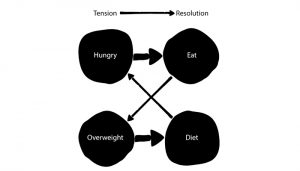Understanding the structures in your life and how they influence your behaviour
Many people try to change their lives for the better, only to find, after a heroic effort, that things haven’t changed at all.
This phenomenon applies to virtually every life endeavor, but it is especially visible in our health. You have likely, at one point or another, tried a diet or tried a workout program. You might have lost some weight and started feeling better but then fell off the wagon. A few months later, the weight is back (perhaps with a little bit extra), and you feel discouraged and frustrated. After putting all of that effort into doing the right thing for your health, you failed.
Why would you want to try again?
You need to understand the patterns in your life so you can reconstruct the structure to illicit the behavior that supports new healthy behavior.
If you faced this challenge, the chances are that you did not change the underlying structures of your daily patterns in your life and behavior. Sure, you made some temporary changes, but the architecture of your life that you’ve built and reinforced for decades never changed, and you fell back into your old pattern once you face some adversity.
Most people have no idea that there are structures at play in their lives. These structures are usually invisible and produce recurring patterns. If you step back and identify the role these structures play in your choices, you can modify them to support the outcomes you desire.
Think about it this way: When you walk through a building, the structure determines the route, how you get from floor to floor and which hallways you need to take to reach your destination. Like a physical structure, your life has routes that it follows. You might deviate from your usual pattern for a few weeks or months, but since the building hasn’t changed, you will eventually go back to traveling the way that most satisfies your needs. Yes I know I shouldn’t go through the library but it cuts off 30 seconds on the way to my cubicle.

This is why the idea that creating health requires some Spartan reserve of self-disciple or some massive boost in self-esteem is misguided. You have to understand the patterns in your life so that you can reconstruct the structure to illicit the behavior that will support my new healthy behavior.
To return to our yo-yo diet example, where you might lose weight only to gain it back again, the challenge of losing weight is rarely as simple as eating the right foods and moving more. The structures around you influence the patterns (or habits) that you fall into.
For example: You might find yourself reaching for a few beers in the evening, every evening. Is the problem that you can’t summon the willpower to resist the temptation to have a drink?
Probably not.
If you retrace your steps and zoom out, you might find that you reach for a beer because:
- You woke up late for work and not feeling rested.
- The commute through rush hour traffic generated stress.
- Your boss came by your desk and yelled at you, increasing your stress.
- You skipped going to the gym because you were tired from work.
- You sat on the couch and watched television to unwind.
- You drank a few beers because that’s what you do when you watch television.
- You had trouble falling asleep that night because of your anxiety about the workday to come.
If you summon the inner strength to not have your nightly drinks under this structure, it won’t matter in the long run. Eventually the patterns will catch up to you and overwhelm your self-control. The structure of your life triggers your habit of wanting and having a drink.
Imagine what would change if you got a good night’s rest, or if you found better ways to cope with your stress, or if you had a career that you looked forward to each day.
It could even start a small change in structure by not bringing beers into your house.
To achieve your goals, you have to understand the structures in your life and how they influence your day to day behaviors.